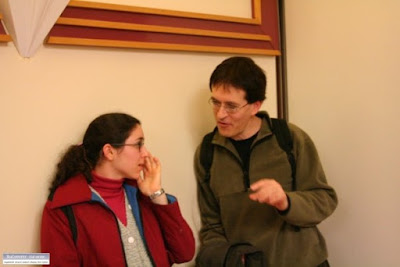In a surprising announcement today, Elections Administrator Brendan Piovesan confirmed that the race for VP Administration, between incumbent Sarah Naiman, “Scary” Mike “the Rabbi” Kushnir, and Yian Messoloras, has been cancelled. The exact reasons are yet unclear, but they involve campaign rules transgressions on the part of one candidate. Apparently, Messoloras broke the rules when he asked people to vote on his laptop computer on the spot. The elections code specifies that candidates cannot pressure people into voting and they have to be at least 10 meters away from voting stations. All the votes that have been submitted on the electronic voting system, which closed yesterday, will be discarded. This may not in fact be allowed, according to AMS elections code, however.
Article 3, Section 7, states: “if serious offences have been committed by more than one candidate in an election, the Elections Committee may declare the results of that election invalid.”
Cancellation thus requires that there be serious offences committed by more than one candidate. As far as we know, here there’s only one. Also, there’s no power to “suspend” an election – only to declare the results invalid. This decision may find itself in Student Court.
Right now though, brand new nominations for the position apprently going to open, and the new race will take place in February. Questions about why the disqualification of the candidate in question, as opposed to the cancellation of the whole race, was the course of action chosen remain unclear. This development will doubtless bode ill for the VP admin race, which will probably have a lower profile and lower voter turnout due to the delay.
This incident is only one in a string of administrative and political gaffes that have marked this elections period. Other notable controversies include the bungled all-candidates’ meeting, too-short campaign period and late and absent updates on the AMS elections website (including updating candidates’ blurbs in a timely fashion). In addition, if you expect to find candidate profiles, media coverage, or posters near the paper ballot voting-booths tomorrow, you may be disappointed. Uninformed voters hoping to make an on-the-spot decision will find it hard to gather information at the voting booths, since Piovesan has confirmed that neither candidate blurbs, nor bulletin boards for posters will be provided at the voting stations. Candidates may independently bring their posters to the voting sites, but according to Piovesan, they will not be officially organized. “No way. I’m not gonna do that,” quoth he.
In the realm of the Voter Funded Media contest, things are not much better. Voting using the Interpolated Consensus counting system is impossible on Web Vote software, and even a simplified voting system has not been organized on the university-controlled program. Therefore, voting for the VFM contest has been delayed, only to take place after the elections are over. It remains unclear on what system this voting will take place. Speculation about the influence of this delay on VFM results abound: will late name-recognition entries that have done no coverage (like the Science and Arts undergraduate newspapers) end up benefiting at the expense of smaller unfunded independent media? We’ll see.
Of course, administration hasn’t been the only issue. Some candidates seem to have stopped showing up to debates. The BoG debate on Monday was notably missing two prominent candidates, and yesterday the VP External debate did not even take place due to the absence of one candidate. Of course, candidates should have the freedom to determine what the most effective campaigning strategies are, but in this elections it seems like unprofessionalism from the administrative side is feeding the same from the candidates to result in a week of exemplary irregularity.
The elections committee redeems itself somewhat by their funny loudspeaker announcements pulling people in to vote on the SUB’s North side, but whether that’s enough to salvage a voter turnout short of disastrous is suspect.



















